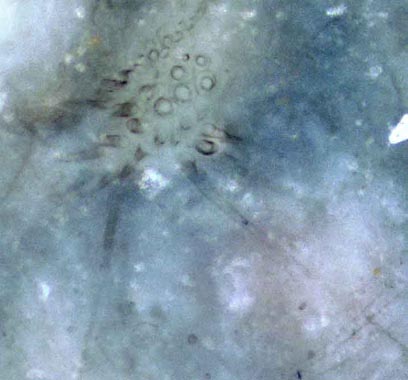Castracollis
hair tufts
Like most crustaceans, Castracollis
has got hairs, spines, and claws
of several sizes on its legs or appendages of various build and
purpose ([1], see also Rhynie
Chert News 34
). Fossilisation in
transparent chert has preserved these delicate objects such that, with
appropriate equipment and due perseverance, they can be found and
identified.
Investigations on own chert samples, performed by D. Waloszek
and his
team at Ulm University, have revealed unexpectedly numerous and long
hairs in tufts on some of the limbs, where they are neatly arranged in
files, see Figs.1,2.

Fig.1: Hairs emerging from mound-like bases on a limb of Castracollis,
not seen at full length here or not seen at all since they have been
cut off by cutting the chert sample into slabs. Width of the picture
0.4mm.
Fig.2 (below): Files of hairs on
a limb of Castracollis, two of them seen at
remarkable length, others cut off. Width of the picture 0.3mm.
Photographs: Ulm University.

Note that these hairs with thickness less than 10Ám become visible in
full length only if they are slightly below and well parallel to the
cut and polished chert face. Obviously, only a few, if any at all, in a
tuft of hair can be expected to meet these conditions.
These images provide another convincing evidence that chert is a most
suitable substance for preserving tiny details of ancient creatures
which would never show up with compression
fossils.
What remains to be found out is the purpose of these uncommonly long
and slender but apparently stiff hairs or bristles. With their regular array on a
bulging surface, thus resembling a manufactured brush, they differ from those on the limbs
probably used as paddles.
H.-J. Weiss
2011
[1] Caroline
Haug, D.
Waloszek, J.T. Haug, H.-J. Weiss
New
morphological
details of the Devonian crustacean Castracollis
wilsonae from the
Rhynie Chert, Scotland. (in
preparation)
 |
 |
43 |





